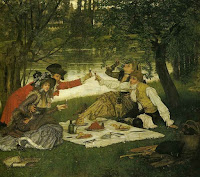 Fire pistons, (or fire syringe, pneumatic syringe, instantaneous light-giving syringe) were ingenious devices created out of wood, horn, bamboo, ivory, bone or metal by the peoples of Southeast Asia. The plunger would force the air in the tube to compress and get very hot, thereby lighting the tinder in the base.
In Europe they were usually a "scientific curiosity." The fire piston on left was from Borneo.
Fire pistons, (or fire syringe, pneumatic syringe, instantaneous light-giving syringe) were ingenious devices created out of wood, horn, bamboo, ivory, bone or metal by the peoples of Southeast Asia. The plunger would force the air in the tube to compress and get very hot, thereby lighting the tinder in the base.
In Europe they were usually a "scientific curiosity." The fire piston on left was from Borneo.Monday, September 30, 2019
Fire starters - fire pistons, fire syringes
 Fire pistons, (or fire syringe, pneumatic syringe, instantaneous light-giving syringe) were ingenious devices created out of wood, horn, bamboo, ivory, bone or metal by the peoples of Southeast Asia. The plunger would force the air in the tube to compress and get very hot, thereby lighting the tinder in the base.
In Europe they were usually a "scientific curiosity." The fire piston on left was from Borneo.
Fire pistons, (or fire syringe, pneumatic syringe, instantaneous light-giving syringe) were ingenious devices created out of wood, horn, bamboo, ivory, bone or metal by the peoples of Southeast Asia. The plunger would force the air in the tube to compress and get very hot, thereby lighting the tinder in the base.
In Europe they were usually a "scientific curiosity." The fire piston on left was from Borneo.Monday, September 23, 2019
Fire starters - flint, steel and tinderbox ... and bamboo strick-a-light
It was hard work lighting and maintaining fires for cooking and heat. A few coals could be saved from the previous day or coals borrowed from a neighbor's fire. Flint and steel was tricky, especially if the "flint was dull, and the steel soft." Then there were the more unknown methods such as the "Bamboo strike-a-light" (bamboo struck by a piece of porcelain).
Wednesday, September 18, 2019
Blow pipes, Iron blowers, Fire-blowing tubes
Six 'iron blowers' were in the 1818 inventory of Virginia Gov. Preston taken in the Virginia Governor's Mansion, built in 1811. They were long thin
tubes with a mouth piece, which were also called ‘fender blower,’ ‘blower,’ 'iron
blow,’ ‘blow tube’ or ‘blow pipe.’
Bellows were also available to start or intensify the kitchen fire.
Tuesday, September 10, 2019
Selling matches on the street
 Boys and women sold matches in cities for a modest fee. They whittled pine or cedar sticks, dipped the pointed end in brimstone or bought the matches from match manufacturers from the "low parts of London." By 1827 an author claimed "the itinerant Matchseller,
will, of consequence, become obsolete." Pictures from prints and books of "Cries" from London, New York City and Boston...
Boys and women sold matches in cities for a modest fee. They whittled pine or cedar sticks, dipped the pointed end in brimstone or bought the matches from match manufacturers from the "low parts of London." By 1827 an author claimed "the itinerant Matchseller,
will, of consequence, become obsolete." Pictures from prints and books of "Cries" from London, New York City and Boston...Tuesday, September 3, 2019
5 centuries of Picnics
Subscribe to:
Posts (Atom)





